Office Room Design: Creating Productive and Inspiring Workspaces
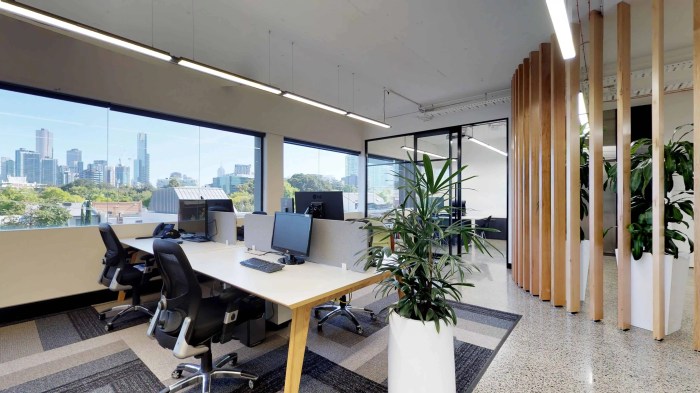
Office room design is not just about aesthetics; it’s about creating a workspace that fosters productivity, enhances employee morale, and reflects the company’s culture. From the layout and furniture choices to the color palette and lighting, every element plays a role in shaping the overall work environment.
A well-designed office can inspire creativity, encourage collaboration, and contribute to employee well-being, ultimately impacting the success of the organization.
This guide explores the key aspects of office room design, providing insights into planning considerations, functional workspace creation, aesthetic enhancements, and the importance of sustainability. We’ll delve into practical strategies for optimizing space utilization, incorporating ergonomic principles, and creating a workspace that is both efficient and inspiring.
The Importance of Office Room Design
The design of an office space can significantly impact employee productivity, morale, and company culture. A well-designed office can foster a positive and productive work environment, while a poorly designed one can lead to decreased productivity, employee dissatisfaction, and a negative company culture.
Impact on Employee Productivity
The design of an office space can have a significant impact on employee productivity. Studies have shown that employees in well-designed offices are more productive, creative, and engaged. For example, natural light has been shown to improve mood, reduce stress, and increase productivity.
- Natural Light: Studies have shown that natural light can improve mood, reduce stress, and increase productivity. Employees who work in offices with access to natural light are often more alert, focused, and creative.
- Ergonomic Furniture: Ergonomic furniture is designed to promote good posture and reduce discomfort, which can lead to increased productivity and reduced fatigue.
- Comfortable Temperature: A comfortable temperature is essential for employee productivity. If the office is too hot or too cold, employees may feel uncomfortable and unable to focus.
- Quiet Workspaces: Employees need quiet workspaces to concentrate and focus. Open-plan offices can be noisy and distracting, which can negatively impact productivity.
Impact on Employee Morale
The design of an office space can also have a significant impact on employee morale. A well-designed office can create a positive and welcoming environment that boosts employee morale.
- Aesthetically Pleasing Design: An aesthetically pleasing office can make employees feel more valued and appreciated.
- Social Spaces: Social spaces, such as break rooms and common areas, can help employees connect and build relationships.
- Personalization: Allowing employees to personalize their workspaces can make them feel more comfortable and at home.
Impact on Company Culture
The design of an office space can also play a role in shaping company culture. A well-designed office can foster a collaborative and innovative culture.
- Collaborative Workspaces: Collaborative workspaces, such as meeting rooms and breakout areas, can encourage teamwork and communication.
- Open-Plan Offices: Open-plan offices can promote transparency and collaboration. However, it’s important to ensure that these spaces are designed to minimize noise and distractions.
- Company Branding: The design of an office space can reflect a company’s brand identity and values.
Relationship Between Office Design and Employee Well-being
Office design is closely linked to employee well-being. A well-designed office can promote physical and mental health.
- Ergonomic Furniture: Ergonomic furniture can help reduce back pain, neck pain, and other musculoskeletal problems.
- Access to Natural Light: Natural light can help regulate circadian rhythms and improve sleep quality.
- Quiet Workspaces: Quiet workspaces can reduce stress and improve mental health.
- Green Spaces: Green spaces, such as plants and gardens, can help reduce stress and improve mood.
Planning and Design Considerations
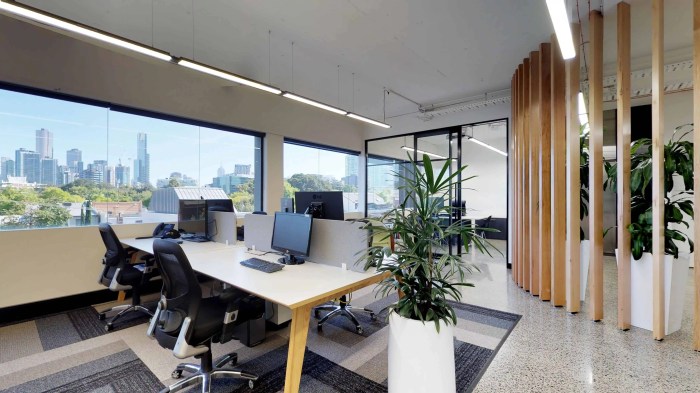
Planning and designing an office room requires careful consideration of various factors to create a functional, efficient, and inspiring workspace. This section will delve into key aspects of planning and design, encompassing budget, space limitations, company goals, layout optimization, and the crucial role of ergonomics.
Budget and Space Limitations
Budget constraints and space limitations are often the primary drivers of office design decisions. It is essential to strike a balance between functionality, aesthetics, and financial feasibility.
- Budget: Establish a realistic budget that aligns with the company’s financial capabilities. This budget should encompass furniture, fixtures, technology, materials, and labor costs.
- Space Limitations: Measure the available space accurately, taking into account existing structures, doorways, and potential obstacles. This information will guide the layout plan and determine the feasibility of different design elements.
Company Goals and Objectives
Office design should reflect the company’s goals, culture, and brand identity. Understanding these aspects is crucial for creating a workspace that supports employee productivity, collaboration, and overall success.
- Company Culture: Consider the company’s culture and values. For example, a company that prioritizes collaboration might opt for an open floor plan with communal workspaces, while a company that emphasizes individual focus might favor private offices.
- Brand Identity: The office design should align with the company’s brand image. This can be achieved through the use of colors, materials, and furniture that reflect the brand’s aesthetic.
- Future Growth: Anticipate future growth and plan accordingly. Consider the potential need for additional workstations, meeting rooms, or other spaces.
Layout Planning and Optimization
Creating a layout plan that optimizes space utilization and flow is essential for maximizing efficiency and creating a comfortable workspace.
- Flow and Circulation: Consider the flow of people and information within the office. The layout should facilitate smooth movement, minimize congestion, and create clear pathways for traffic.
- Workstation Placement: Strategically position workstations to optimize natural light, minimize distractions, and promote collaboration where needed.
- Meeting and Collaboration Spaces: Allocate dedicated areas for meetings, brainstorming sessions, and team collaboration.
- Storage and Organization: Provide ample storage space for files, equipment, and personal belongings. This helps to maintain a clutter-free and organized workspace.
Ergonomics in Office Design
Ergonomics plays a critical role in creating a healthy and productive work environment. This involves designing workspaces that minimize physical strain and promote comfort.
- Seating: Invest in comfortable and adjustable chairs that provide proper lumbar support and allow for personalized height adjustments.
- Desk Height: Ensure that desk height is suitable for the user’s posture, allowing for a neutral wrist position and minimizing strain on the neck and shoulders.
- Lighting: Provide adequate and balanced lighting. Natural light is ideal, but artificial lighting should be used to supplement and ensure sufficient illumination throughout the workspace.
- Monitor Placement: Position monitors at eye level to minimize neck strain and promote a neutral head position.
- Keyboard and Mouse: Choose ergonomic keyboards and mice that promote a neutral hand position and minimize strain on wrists and fingers.
Creating a Functional Workspace
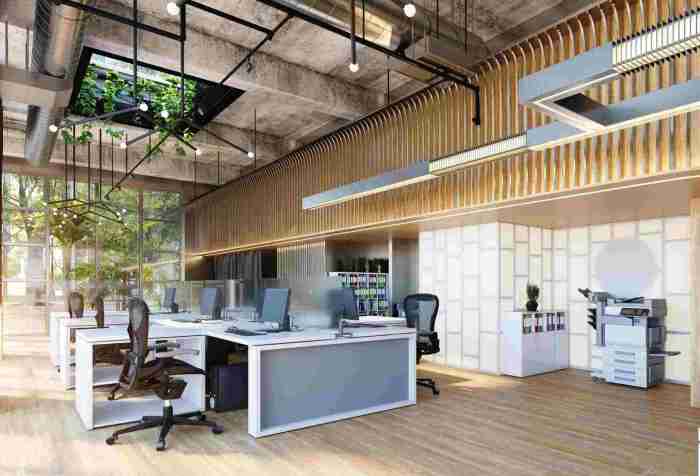
A well-designed workspace is crucial for productivity, comfort, and overall well-being. It should be tailored to the specific needs of the individual or team using it. This section will delve into the essential components of a functional workspace, focusing on furniture, equipment, organization, and different desk configurations.
Furniture and Equipment
The furniture and equipment chosen for a workspace significantly impact its functionality and comfort. The following list Articles essential components and considerations:
- Desks: Desks are the central hub of a workspace, providing a surface for work, technology, and storage. The size, shape, and height of the desk should be suitable for the tasks performed and the individual’s physical needs. For example, a large L-shaped desk might be ideal for a team workspace, while a smaller, adjustable desk might be better for a home office.
- Chairs: Comfortable and ergonomically designed chairs are essential for preventing back pain, neck strain, and fatigue. Adjustable chairs that allow for customization of height, back support, and armrests are highly recommended. Consider investing in chairs with lumbar support and breathable fabric to promote comfort and airflow.
- Storage Solutions: Efficient storage solutions are crucial for keeping a workspace organized and clutter-free. This can include drawers, shelves, cabinets, and filing systems. Choose storage options that are accessible, well-labeled, and cater to the specific needs of the workspace.
- Technology: The technology used in a workspace is a key factor in its functionality. This includes computers, monitors, printers, scanners, and other devices. Ensure that the technology is reliable, user-friendly, and meets the specific requirements of the work being done. Consider investing in ergonomic accessories like a mouse pad with wrist support and a monitor stand to promote good posture.
Workspace Organization
Organizing a workspace effectively is essential for maximizing efficiency and minimizing distractions. The following strategies can help create a more functional and productive environment:
- Declutter: Regularly remove unnecessary items from the workspace to create a clean and organized environment. This includes old documents, unused supplies, and personal items that don’t contribute to productivity.
- Assign a Place for Everything: Designate specific locations for all items in the workspace, including stationery, technology, and personal belongings. This helps ensure that everything has a place and can be easily found.
- Vertical Storage: Utilize vertical space for storage to maximize floor space and minimize clutter. This can include shelves, cabinets, and wall-mounted organizers.
- Minimize Visual Distractions: Keep the workspace free from clutter and distractions that can hinder focus. This includes removing unnecessary posters, personal photos, or other visual elements that might draw attention away from work.
- Use Color and Light: Color and light can significantly impact mood and productivity. Choose calming and stimulating colors for the workspace, and ensure adequate lighting for optimal visibility and comfort.
Desk Configurations
Various desk configurations cater to different workspace needs and preferences. The following examples illustrate some common configurations and their advantages and disadvantages:
- Single Desk: A single desk is the most basic configuration, suitable for individual workspaces.
- Advantages: Provides a dedicated workspace for one person, offering privacy and control over the environment. It is also relatively inexpensive and easy to set up.
- Disadvantages: Can feel cramped and limiting, especially for individuals who require a lot of space or work with multiple devices.
- L-Shaped Desk: An L-shaped desk offers more workspace and storage options compared to a single desk.
- Advantages: Provides ample space for work, technology, and storage. It can also be configured to create a more collaborative workspace, especially when combined with a shared table or meeting area.
- Disadvantages: Can be more expensive than a single desk and may require more space.
- Standing Desk: A standing desk allows for alternating between sitting and standing throughout the day, promoting better posture and reducing the risk of health issues associated with prolonged sitting.
- Advantages: Improves posture, increases energy levels, and reduces the risk of health problems. It can also boost creativity and productivity.
- Disadvantages: Can be expensive, and some individuals may find it uncomfortable to stand for extended periods.
- Hot Desking: A hot desking arrangement involves employees sharing desks, with no assigned workstations.
- Advantages: Can save space and costs, and promote flexibility and collaboration.
- Disadvantages: This can be disruptive, especially for individuals who require a consistent workspace. It may also lead to a lack of personal space and storage options.
Enhancing Aesthetics and Atmosphere
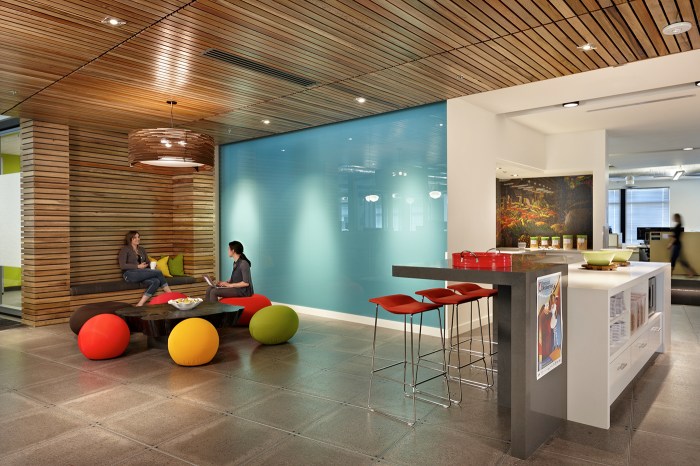
A well-designed office space goes beyond functionality; it also plays a crucial role in shaping the overall aesthetic and atmosphere, directly impacting employee well-being and productivity. Creating a visually appealing and inviting environment can foster a sense of creativity, motivation, and collaboration.
Color Palettes and Textures
The choice of color palettes, textures, and materials significantly influences the mood and perception of a space.
- Color Psychology: Colors evoke specific emotions and associations. For instance, blue often conveys calmness and focus, while green promotes tranquility and growth. Using a balanced color scheme that aligns with the desired atmosphere is essential.
- Texture and Materials: The interplay of textures adds depth and visual interest. Natural materials like wood and stone create a warm and inviting feel, while metallic accents can add a modern touch.
Incorporating Natural Elements
Bringing the outdoors in can significantly enhance the aesthetic and atmosphere of an office space.
- Plants: Plants not only add visual appeal but also improve air quality, reduce stress, and boost mood. Choosing low-maintenance plants that thrive in indoor environments is crucial.
- Windows: Maximizing natural light through strategically placed windows is vital. Natural light promotes well-being and improves focus.
Lighting Scheme
A well-designed lighting scheme provides adequate illumination while creating a comfortable and inviting atmosphere.
- Layered Lighting: Combining different types of lighting, such as ambient, task, and accent lighting, allows for flexibility and control.
- Natural Light: Maximizing natural light during the day reduces the need for artificial lighting, promoting energy efficiency and employee well-being.
- Color Temperature: Warm white light (2700-3000K) is generally preferred for creating a cozy and inviting atmosphere, while cool white light (4000-4500K) is more suitable for tasks requiring focus and concentration.
Collaboration and Communication
In today’s dynamic business landscape, fostering collaboration and communication within the office is crucial for success. A well-designed office space can significantly enhance teamwork, idea exchange, and overall productivity.
Designing Collaborative Spaces
Creating dedicated spaces for collaboration is essential for fostering communication and teamwork. These spaces should be designed to encourage interaction and facilitate seamless information flow.
- Meeting Rooms: Meeting rooms are essential for formal discussions, presentations, and brainstorming sessions. They should be equipped with comfortable seating, whiteboards, projection screens, and video conferencing capabilities to accommodate diverse meeting needs.
- Breakout Areas: Breakout areas offer a more informal setting for team members to gather, relax, and engage in casual conversations. These spaces can be equipped with comfortable seating, coffee tables, and collaborative work surfaces.
- Shared Workspaces: Shared workspaces, such as open-plan offices or co-working areas, provide opportunities for team members to interact and work together on projects. These spaces should be designed with ample natural light, ergonomic furniture, and acoustic panels to minimize distractions and promote focus.
The Role of Technology in Collaboration
Technology plays a vital role in facilitating collaboration and communication in the office. Modern tools and platforms enhance team interaction, knowledge sharing, and project management.
- Video Conferencing: Video conferencing platforms allow team members to connect remotely and participate in meetings, presentations, and brainstorming sessions as if they were in the same room.
- Project Management Software: Project management tools streamline collaboration by providing a central platform for task assignments, progress tracking, and communication.
- Cloud-Based Collaboration Tools: Cloud-based platforms enable team members to access and share documents, files, and projects from anywhere with an internet connection.
Sustainability and Green Design: Office Room Design
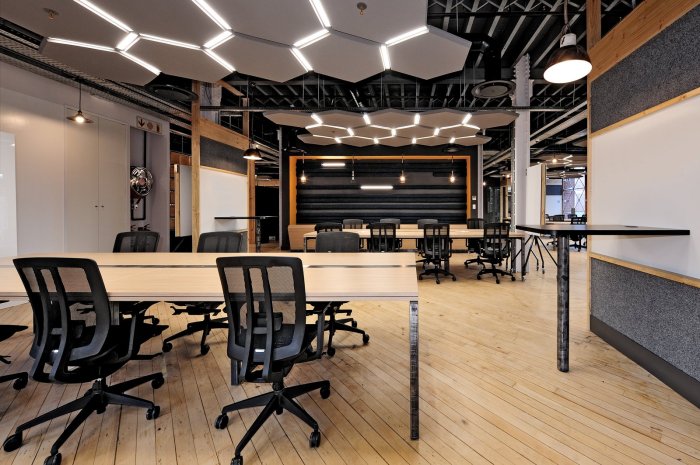
Incorporating sustainability into office room design is not just a trend; it’s a responsible approach to creating a workspace that minimizes environmental impact while promoting employee well-being. Green design principles emphasize energy efficiency, resource conservation, and the use of eco-friendly materials.
This section explores how to implement sustainable elements in office design, highlighting the benefits of such an approach.
Energy-Efficient Lighting and Materials
Energy-efficient lighting plays a crucial role in reducing energy consumption and promoting sustainability.
- LED lighting is significantly more energy-efficient than traditional incandescent bulbs, consuming up to 80% less energy. This translates to lower electricity bills and a reduced carbon footprint.
- Natural lighting is a sustainable and cost-effective way to illuminate the workspace. Designing offices with large windows that allow ample natural light to penetrate can reduce the reliance on artificial lighting during daylight hours.
- Smart lighting systems can further optimize energy efficiency by automatically adjusting lighting levels based on occupancy and natural light availability.
Choosing sustainable materials for office furniture, flooring, and finishes is another essential aspect of green design.
- Recycled materials, such as recycled plastic, metal, and wood, reduce the demand for virgin resources and minimize waste.
- Bio-based materials, derived from renewable sources like bamboo, cork, and soy-based products, offer a sustainable alternative to traditional materials.
- Low-VOC paints and finishes minimize harmful emissions into the indoor environment, contributing to a healthier workspace.
Benefits of Using Recycled or Eco-Friendly Materials, Office Room Design
The use of recycled or eco-friendly materials in office design offers numerous benefits beyond environmental sustainability.
- Reduced environmental impact: By using recycled materials, we reduce the need to extract new resources, minimizing deforestation, pollution, and greenhouse gas emissions.
- Improved indoor air quality: Eco-friendly materials, such as low-VOC paints and finishes, release fewer harmful chemicals into the air, creating a healthier and more comfortable workspace.
- Enhanced brand image: Companies that prioritize sustainability often attract and retain talent, as well as enhance their brand image and reputation among environmentally conscious consumers.
Green Design and a Healthier Work Environment
Green design principles contribute to a healthier and more sustainable work environment by addressing factors that impact employee well-being.
- Improved air quality: Natural ventilation, green plants, and low-VOC materials help create a healthier indoor environment by reducing air pollution and enhancing air circulation.
- Enhanced natural light: Ample natural light improves employee mood, productivity, and overall well-being. It also reduces the need for artificial lighting, saving energy and reducing eye strain.
- Increased employee satisfaction: A sustainable office environment can boost employee morale and satisfaction, leading to increased productivity and a more positive work culture.
Inspiration and Case Studies
Exploring successful office room designs from various industries provides valuable insights into effective design principles and their impact on workplace culture, productivity, and employee well-being. By analyzing the design elements and features that contribute to the success of these spaces, we can gain a deeper understanding of how to create inspiring and functional work environments.
Examples of Successful Office Room Designs
Successful office room designs often prioritize employee well-being, collaboration, and productivity. These spaces are typically characterized by a blend of functionality, aesthetics, and sustainability. Here are some examples of successful office room designs across different industries:
- Googleplex, Mountain View, California: Google’s headquarters is a prime example of a playful and innovative office design. It features open floor plans, collaborative workspaces, vibrant colors, and unique amenities like slides, nap pods, and on-site cafes. This approach fosters creativity and encourages employees to interact and collaborate.
- Spotify, Stockholm, Sweden: Spotify’s office is designed to reflect the company’s music-centric culture. It features soundproof booths for focused work, open areas for collaboration, and music-themed design elements. The office also incorporates sustainable features, such as recycled materials and energy-efficient lighting.
- Zappos, Las Vegas, Nevada: Zappos’s office emphasizes a casual and collaborative atmosphere. The company has implemented an open floor plan with a focus on transparency and communication. The office also includes unique features like a bowling alley, a playground, and a dog-friendly environment, fostering a sense of community and fun.
Design Elements and Features that Contribute to Success
Several design elements and features contribute to the success of these office spaces:
- Open Floor Plans: Open floor plans promote collaboration and communication by creating a sense of openness and transparency. They can also enhance natural light and air circulation.
- Collaborative Workspaces: Dedicated areas for group meetings, brainstorming sessions, and team projects foster a sense of community and encourage teamwork.
- Ergonomic Furniture: Comfortable and adjustable chairs, desks, and workstations promote employee well-being and reduce the risk of injuries.
- Natural Light and Ventilation: Natural light and ventilation improve employee mood, focus, and productivity.
- Technology Integration: Seamless integration of technology, such as video conferencing, wireless internet, and digital displays, enhances communication and collaboration.
- Employee-Centric Amenities: Amenities such as on-site gyms, cafes, and relaxation areas contribute to employee well-being and create a more positive work environment.
Challenges and Opportunities in Office Design
Designing effective office spaces presents both challenges and opportunities:
- Balancing Privacy and Collaboration: Striking a balance between open collaboration areas and private spaces for focused work is crucial.
- Adapting to Changing Work Styles: Office designs need to be flexible and adaptable to accommodate evolving work styles, such as remote work and flexible schedules.
- Sustainability and Green Design: Incorporating sustainable materials, energy-efficient technologies, and waste reduction strategies is essential for creating environmentally responsible office spaces.
- Budget Constraints: Designing an effective office space within budget constraints can be challenging.
- Technology Integration: Integrating technology seamlessly and ensuring it enhances rather than hinders productivity and collaboration is crucial.
Conclusion
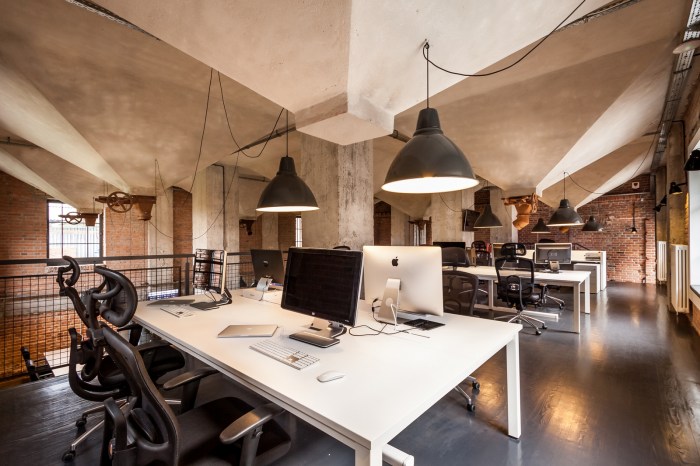
By thoughtfully designing an office room, businesses can create a space that not only meets functional needs but also elevates the employee experience. From boosting productivity to fostering a positive work culture, the impact of office design extends beyond aesthetics, shaping the overall success of the organization.
By incorporating the principles Articulated in this guide, businesses can transform their office spaces into vibrant and productive hubs, empowering employees to thrive and achieve their best work.
Comments are closed.